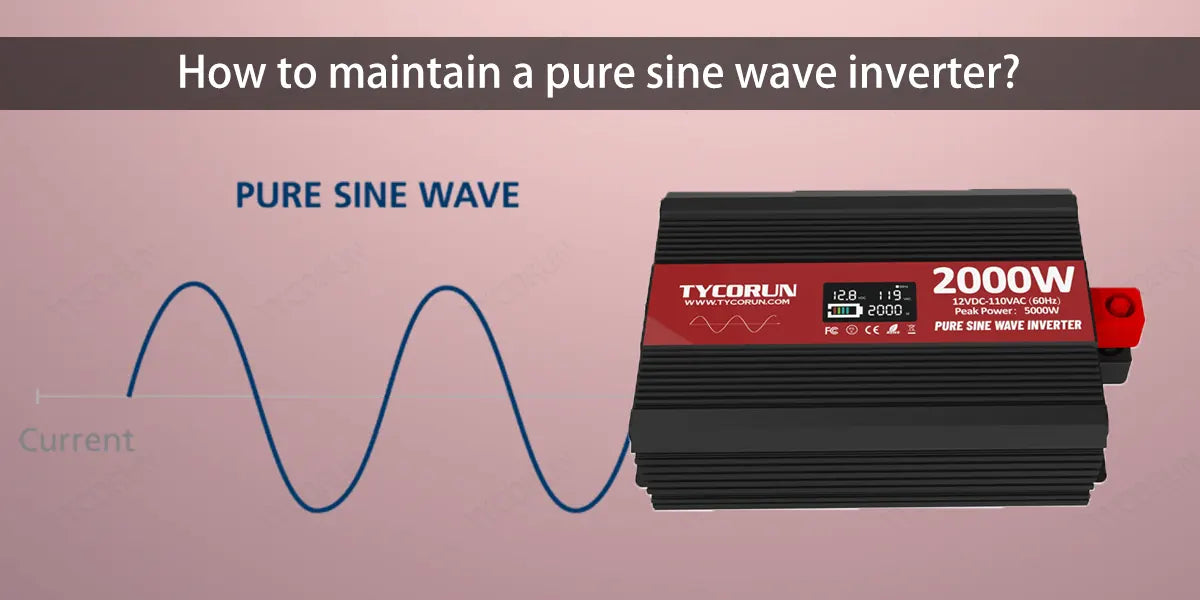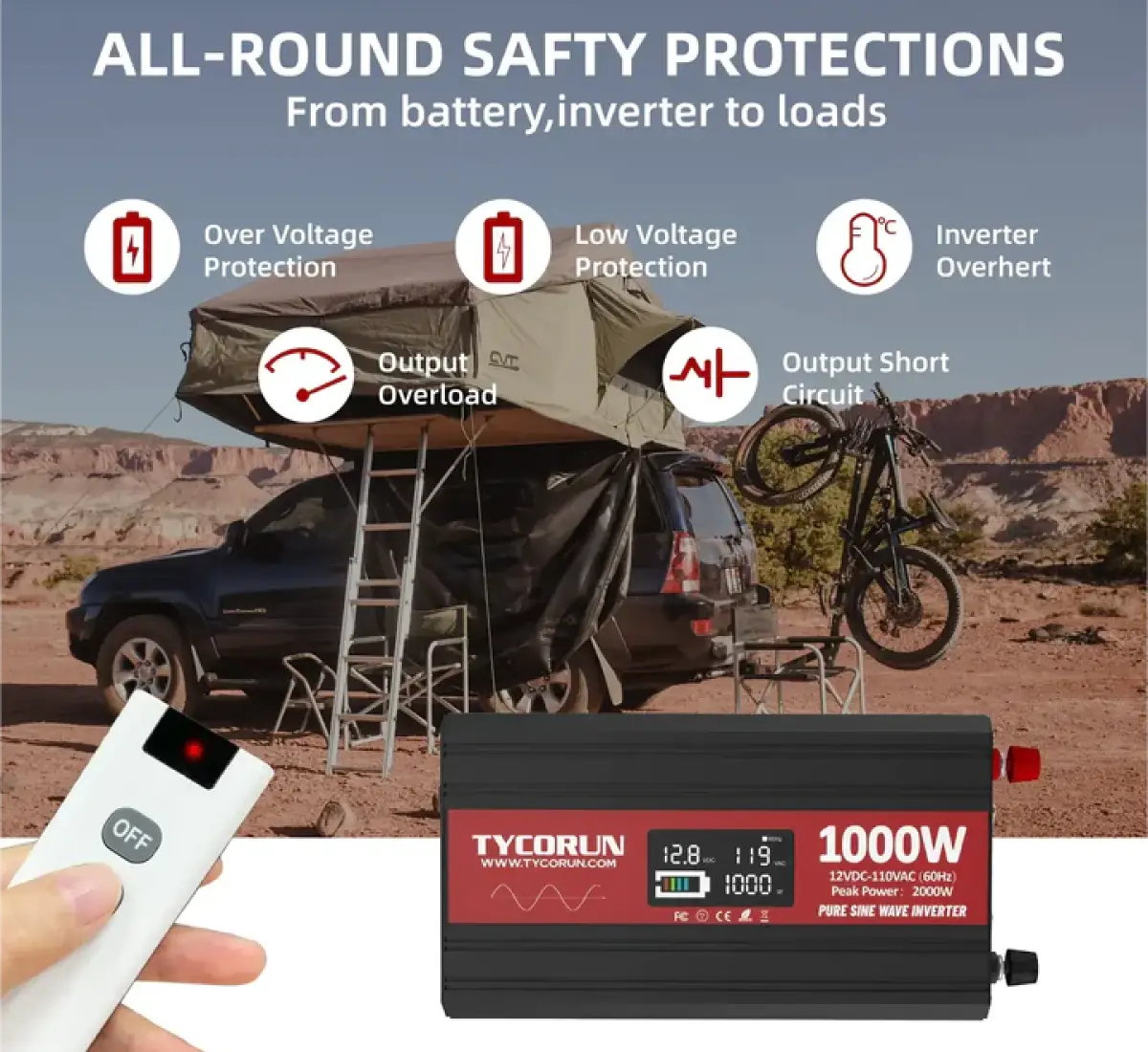
The debate surrounding pure sine wave vs modified sine wave inverter has been a significant topic in the realm of power inverters. Both varieties possess distinct characteristics and applications, underscoring the importance for consumers to comprehend these variances and select the appropriate inverter based on their requirements.
This comprehensive guide extensively examines the intricacies and subtleties of pure sine wave vs modified sine wave inverter, delving into their features, benefits, and ideal usage scenarios.
Main content:
- What is a pure sine wave inverter?
- What is a modified sine wave inverter?
- Difference between modified and pure sine wave inverters
- Pure sine wave vs modified sine wave inverter - Which is better?
- Advantages of pure sine wave inverters over modified sine wave inverters
- What should you not use a modified sine wave inverter for?
- Is it worth getting a pure sine wave inverter?
- Is my device suitable for a modified or pure sine wave inverter?
- How to maintain a pure sine wave inverter?
- FAQs
1. What is a pure sine wave inverter?
A pure sine wave inverter generates an electrical output that replicates the seamless and undulating waveform of utility grid power. It replicates the natural sine wave, ensuring a clean and stable power supply similar to what we receive from conventional power outlets.
A wide range of electronic devices, including delicate equipment like medical devices, music systems, and small appliances on RVs or trucks, all can be powered by pure sine wave inverters.
Click the picture for more information of 1000w pure sine wave inverter:
2. What is a modified sine wave inverter?
A modified sine wave inverter, on the other hand, produces an output that more closely resembles a stepped waveform than a smooth sine wave. The modified sine wave has a blockier, less refined power output despite being a more affordable option.
These inverters work well for powering simple tools and appliances, but because of possible compatibility issues, they might not be the best choice for delicate electronics.
3. Difference between modified and pure sine wave inverters
Here are a few aspects to consider when comparing pure sine wave vs modified sine wave inverter.
- Applicable equipment:
A modified sine wave inverter can only run certain devices that are insensitive to power quality, whereas a pure sine wave inverter can run any device that needs AC power. A modified sine wave inverter may not function properly or at all in certain devices, such as cordless tools, variable speed motors, audio and video equipment, digital clocks, laser printers, fax machines, and so on, and may even damage some delicate electronic equipment.
- Efficiency:
Another difference between modified and pure sine wave inverters is their efficiency. A pure sine wave inverter is more effective and can convert more DC power to AC power with less losses than a modified sine wave inverter. The efficiency of a modified sine wave inverter is about 70-80%, while pure sine wave inverter exceeds 90%. You may reduce the loss of the 12v battery to a certain extent and lower the heat produced by the inverter and the device by using a pure sine wave inverter.
On the other hand, a modified sine wave inverter loses more DC power as heat and noise and is less efficient than a pure sine wave inverter. Your LFP battery will run out of power more quickly, and the inverter and device will get hotter using a modified sine wave inverter.

- Quality:
When comparing the quality of a pure sine wave vs modified sine wave inverter, the former minimizes the likelihood of electrical interference and damage to sensitive appliances by guaranteeing a superior power output. Modified sine wave inverters are prone to damage.
Because the principle of the modified sine wave inverter is to convert the mains frequency alternating current into a digital signal through a rectifier and filter circuit, then convert it into a high-frequency alternating current through a high-power switching tube, and finally convert the high-frequency alternating current into a direct current through the inverter. Problems such as switch tube damage and capacitor damage may occur during this process.
- Service life:
Pure sine wave inverter typically has a longer service life because it consumes less energy when outputting power, while the modified sine wave inverter consumes more power because it generates certain clutter when outputting power. In addition, during the application process of pure sine wave inverters, the probability of failure is relatively small and the service life is usually relatively long.

4. Pure sine wave vs modified sine wave inverter - Which is better?
The answer to which is better among pure sine wave vs modified sine wave inverter depends on your needs, preferences, and budget. In terms of performance, quality, and dependability, a pure sine wave inverter is unquestionably superior to a modified sine wave inverter. However, it is also more costly and intricate.
A pure sine wave inverter is the suggested choice for situations where precision and dependability are crucial, such as high-end audio systems or medical settings. On the other hand, a modified sine wave inverter is less expensive than a pure sine wave inverter, but it also has lower compatibility, lower efficiency, and lower durability.
Therefore, when you need to run some simple power equipment with low precision requirements in the short term, the modified sine wave inverter is a choice that can be considered.

5. Advantages of pure sine wave inverters over modified sine wave inverters
There are more advantages to pure sine wave vs modified sine wave inverter:
- It can run any device that requires AC power.
- Improved efficiency and reduced energy consumption. It can save you more battery power and reduce the heat generated by the inverter and the device.
- It can enhance the performance and lifespan of sensitive electronics.
- It has a lower risk of electronic interference and harmonic distortion.
- Some high-quality pure sine wave inverters have LED displays for easy observation of the machine status. For example, TYCORUN's full series of inverters, such as 2000w pure sine wave inverter, are equipped with LCD LED displays with accuracy of up to 98%, accurately and in real time display of information like output power and battery status.

6. What should you not use a modified sine wave inverter for?
Avoid using a modified sine wave inverter for:
- Sensitive electronics such as medical devices and audio equipment.
- Inductive load electrical appliances, such as electric fans, televisions, etc.
- Electronic load appliances, such as computers, dimmers, electronic devices with touch screens, etc.
- Appliances with motors or compressors as they may experience reduced efficiency and increased wear.
- Devices that have a high power rating.
7. Is it worth getting a pure sine wave inverter?
The response to this query will vary based on your electricity requirements and budget. If you have limited funds and basic requirements that don't call for a pure sine wave, a modified sine wave inverter may be a good option.
However, if you have a higher budget and need to power various devices that require a pure sine wave, then a pure sine wave inverter is worth getting. While the initial costs are higher, the long-term benefits of performance and device lifespan often outweigh the upfront expenditure.
8. Is my device suitable for a modified or pure sine wave inverter?
To determine whether your device is suitable for a modified or pure sine wave inverter, you need to check the specifications of your device and the inverter. You need to compare factors such as your devices' power rating, surge ratings, and waveform that your appliances require.
We advise going with the TYCORUN pure sine wave inverters if you want the best inverter for your gadgets. Because of their long lifespan, clean power output, smart LED display, powerful short circuit protection, low no-load current (0.6A), and excellent efficiency, the inverters can be used in a greater variety of applications.

9. How to maintain a pure sine wave inverter?
Regular maintenance ensures a pure sine wave inverter's long life and optimal performance. Keep the following tips in mind:
- Keep the inverter clean and free from dust.
- Ensure proper ventilation to prevent overheating.
- Check and tighten electrical connections periodically, keeping them connected and grounded.
- Keep your inverter checked and serviced. You need to inspect your inverter regularly.
10. FAQs
① Will a modified sine wave inverter damage my electronics?
Yes, modified sine wave inverters may damage electronic devices. It is not suitable to use modified sine wave inverters to power inductive load appliances such as refrigerators and electric drills for a long time. Otherwise, the components of the inverter and the electric products may be damaged or the expected service life may be shortened.
② Differences in cost between modified and pure sine wave inverters
Generally speaking, modified sine wave inverters are less expensive upfront. The price of a inverter is determined by factors such as wattage, voltage and brand. A 3000w modified wave inverter costs about US$50-100, and a 3000w pure sine wave inverter costs about US$250-400 or even higher.
The TYCORUN 3000w inverter is currently on sale, priced at only US$199.99. Compared with inverters with the same parameters, it not only guarantees the quality, but also has a high cost performance, makes it a perfect choice for you!
③ Is the efficiency of a pure sine wave inverter better than a modified one?
Indeed, pure sine wave inverters are renowned for their superior performance in minimizing energy waste, and the efficiency of pure sine wave inverters is usually over 90%.
For more information about Tycorun inverters, please check our pure sine wave inverter 3000w, 2000 watt car inverter, car inverter 1000 watt, 500w car inverter
Related posts: 12 volt 100ah deep cycle lithium battery, 12v 200ah deep cycle battery, 18650 battery

















